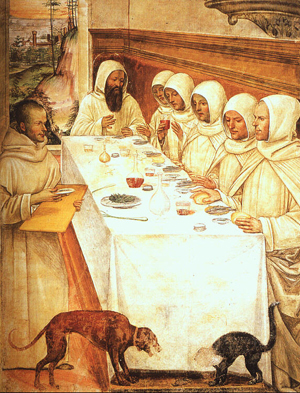THE NAME OF THE ROSE:
-This film from the 14th Century is about an abbey of benedictine monks which follows the motto "Ora et labora" (pray and work). This abbey is situated between the south of France and the north of Italy. During the film they occur several crimes, and so the abbot called a very clever Franciscan monk for his help with the crimes. Finally he resolve the crimes.
The story is developed around the library due to the fact that it is full of very important manuscripts.
-During the film you can see the daily life of the monks inside the abbey. The monks distributed the time between prayers and some different labours organised by the abbot, keeping the liturgical hours (hours at which they pray following the rule of St. Benedict) that according to the month in which the flim is developed (November) they are the following:
- Matins: between 2:30 and 3:00 a.m.
- Lauds: between 5:00 and 6:00 a.m.
- Prime: around 7.30 a.m.
- Terce: at 9:00 a.m.
- Sext: while they have lunch
- None: between 14:00 and 15:00 p.m.
- Vespers: around 16:30 while they have dinner
- Compline: around 18:00 p.m.
-The different labours they make during the film are:
- Copy manuscripts in the Scriptorum: this activity is make by the most literate monks.
- Recolecting medicinal plants: is done by a person called The Apothecary.

- The rest of the monks dedicate their time with other activities like: Working on the arable lands, cooking and caring for livestock.
-The monks eat all together at the Refectory. They have to eat in silence while one of them reads some christian texts.
-They sleep in individual cells and they go to sleep at seven o'clock p.m..
-In the film you can also see how some processes of the inquisition take place inside the main abbey conducted by other monks sent by the Pope. This is done because they think that there can be some heretics persons.









